Woolworths Company: Tax Implication and Corporate Tax Analysis Report
VerifiedAdded on 2020/05/16
|12
|2267
|87
Report
AI Summary
This report provides a comprehensive analysis of the tax implications and corporate tax practices of Woolworths. It examines the company's equity capital structure, income tax expenses, and compliance with tax rules and regulations. The report delves into the differences between accounting income and taxable income, the treatment of deferred tax assets and liabilities, and the relationship between income tax expenses and income tax payable. Furthermore, it explores the discrepancies between income tax expenses in the income statement and income tax paid in the cash flow statement, providing insights into the underlying reasons. The analysis also addresses the treatment of tax in the company's books of accounts, highlighting interesting, difficult, and surprising aspects of tax recording, and offering new insights into compliance with international and domestic taxation rules. The report utilizes Woolworths' annual reports to support its findings and conclusions.

RUNNING HEAD: Tax implication and corporate tax analysis
1
Name of the student-
Topic- Tax implication and corporate tax analysis
University name
1
Name of the student-
Topic- Tax implication and corporate tax analysis
University name
Paraphrase This Document
Need a fresh take? Get an instant paraphrase of this document with our AI Paraphraser
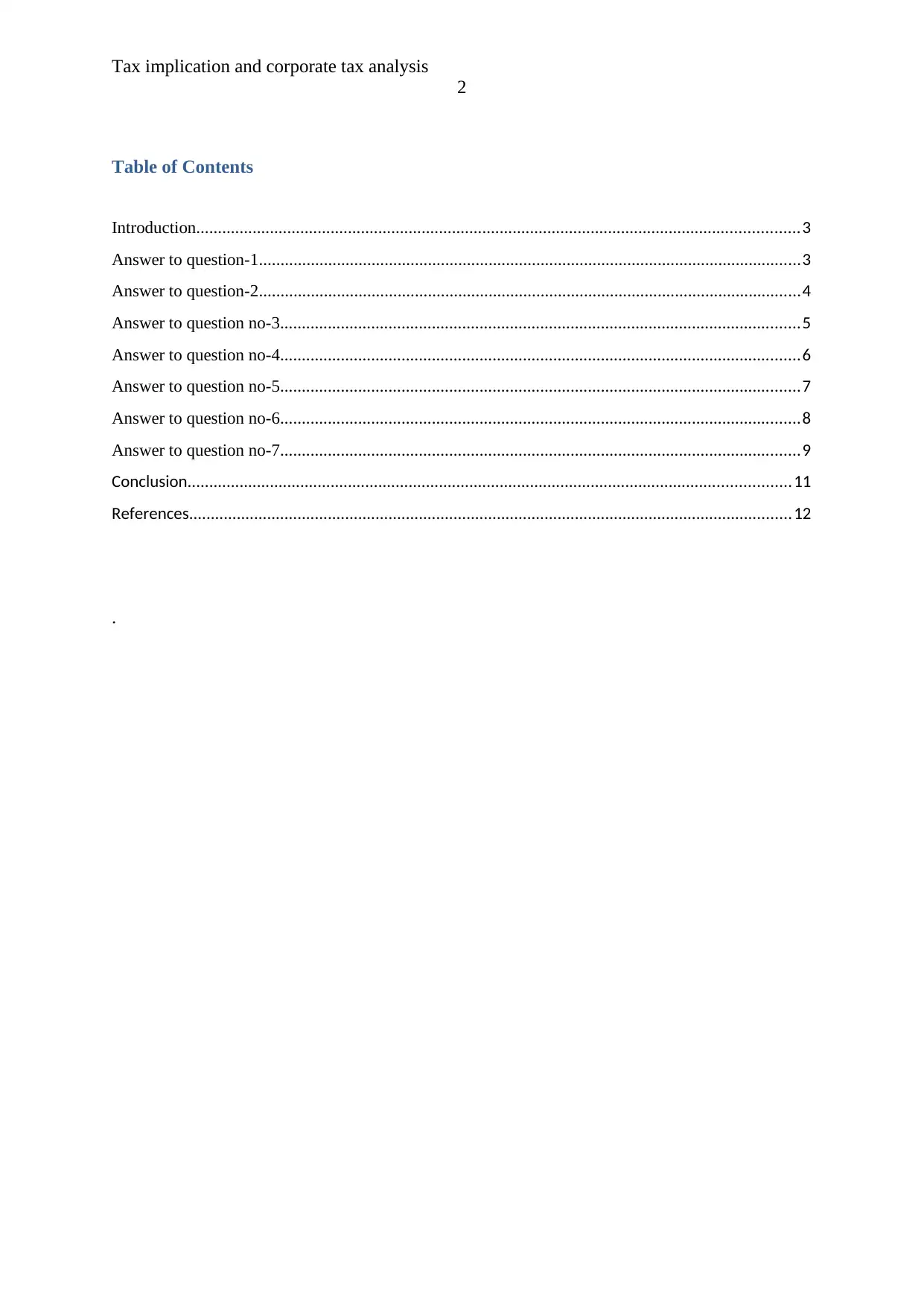
Tax implication and corporate tax analysis
2
Table of Contents
Introduction...........................................................................................................................................3
Answer to question-1.............................................................................................................................3
Answer to question-2.............................................................................................................................4
Answer to question no-3........................................................................................................................5
Answer to question no-4........................................................................................................................6
Answer to question no-5........................................................................................................................7
Answer to question no-6........................................................................................................................8
Answer to question no-7........................................................................................................................9
Conclusion...........................................................................................................................................11
References...........................................................................................................................................12
.
2
Table of Contents
Introduction...........................................................................................................................................3
Answer to question-1.............................................................................................................................3
Answer to question-2.............................................................................................................................4
Answer to question no-3........................................................................................................................5
Answer to question no-4........................................................................................................................6
Answer to question no-5........................................................................................................................7
Answer to question no-6........................................................................................................................8
Answer to question no-7........................................................................................................................9
Conclusion...........................................................................................................................................11
References...........................................................................................................................................12
.

Tax implication and corporate tax analysis
3
Introduction
In this report, income tax provisions and rules of corporate bodies have been taken
into consideration. This report is prepared on the Woolworths company which has charged
income tax and prepared its financial statements as per the income tax rules and regulations.
Answer to question-1
After evaluating the annual report of company, it is evaluated that equity capital of company
is accompanied with the three main parts namely, contributed capital, retained earnings and
reserve of company. The equity capital of Woolworths Company is accompanied with the
following parts.
Woolworths Company has divided its equity capital into following parts
Common Stock
Other Accumulated profit
Retained earnings or distributable profit
Contributed capital of company- It is the amount of capital invested by company for the
consideration of the ownership they take from the company (Woolworths Company, 2017).
Retained earnings- It is the amount of profit collected by the company from its earned
profit. It is the plugged back by company or distributed to its equity shareholders
(Woolworths, 2017).
3
Introduction
In this report, income tax provisions and rules of corporate bodies have been taken
into consideration. This report is prepared on the Woolworths company which has charged
income tax and prepared its financial statements as per the income tax rules and regulations.
Answer to question-1
After evaluating the annual report of company, it is evaluated that equity capital of company
is accompanied with the three main parts namely, contributed capital, retained earnings and
reserve of company. The equity capital of Woolworths Company is accompanied with the
following parts.
Woolworths Company has divided its equity capital into following parts
Common Stock
Other Accumulated profit
Retained earnings or distributable profit
Contributed capital of company- It is the amount of capital invested by company for the
consideration of the ownership they take from the company (Woolworths Company, 2017).
Retained earnings- It is the amount of profit collected by the company from its earned
profit. It is the plugged back by company or distributed to its equity shareholders
(Woolworths, 2017).
⊘ This is a preview!⊘
Do you want full access?
Subscribe today to unlock all pages.

Trusted by 1+ million students worldwide

Tax implication and corporate tax analysis
4
Equity (Amount in dollar
million) ($M)
2017 2016
Common stock 5615 5252
Retained earning 3797 3125
Total equity 114 94
Discussion of equity part of the company
It is observed that Woolworths Company has increased its equity capital and retained earning
throughout the time. It is a good indicator for company. However, accumulated earning has
also increased throughout the time. Total equity capital of company has increased by 12% in
2017 as compared to last year data (Woolworths Company, 2017).
Answer to question-2
Income tax expense is the amount of money which is needed to be paid by company
on its earning to government. It is shown as charged on the profit in the books of account of
company. It is observed that company has been paying high amount of taxes to government
on its profit. Therefore, it requires implementing effective tax planning to reduce the tax
payment (Woolworths Company, 2017).
Particular(AUD $ in million) 2016 2017
Income tax expenses 520 650
4
Equity (Amount in dollar
million) ($M)
2017 2016
Common stock 5615 5252
Retained earning 3797 3125
Total equity 114 94
Discussion of equity part of the company
It is observed that Woolworths Company has increased its equity capital and retained earning
throughout the time. It is a good indicator for company. However, accumulated earning has
also increased throughout the time. Total equity capital of company has increased by 12% in
2017 as compared to last year data (Woolworths Company, 2017).
Answer to question-2
Income tax expense is the amount of money which is needed to be paid by company
on its earning to government. It is shown as charged on the profit in the books of account of
company. It is observed that company has been paying high amount of taxes to government
on its profit. Therefore, it requires implementing effective tax planning to reduce the tax
payment (Woolworths Company, 2017).
Particular(AUD $ in million) 2016 2017
Income tax expenses 520 650
Paraphrase This Document
Need a fresh take? Get an instant paraphrase of this document with our AI Paraphraser
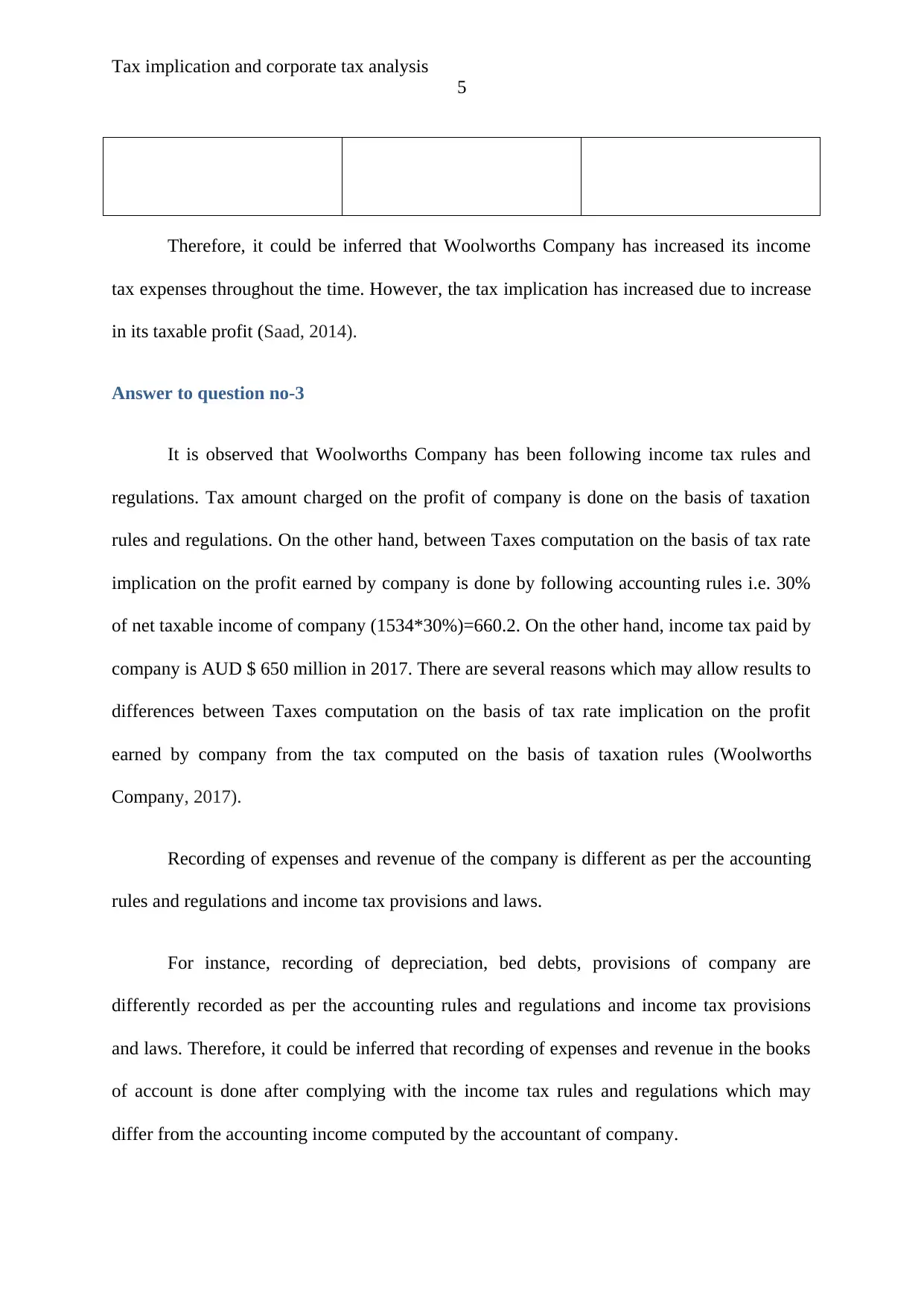
Tax implication and corporate tax analysis
5
Therefore, it could be inferred that Woolworths Company has increased its income
tax expenses throughout the time. However, the tax implication has increased due to increase
in its taxable profit (Saad, 2014).
Answer to question no-3
It is observed that Woolworths Company has been following income tax rules and
regulations. Tax amount charged on the profit of company is done on the basis of taxation
rules and regulations. On the other hand, between Taxes computation on the basis of tax rate
implication on the profit earned by company is done by following accounting rules i.e. 30%
of net taxable income of company (1534*30%)=660.2. On the other hand, income tax paid by
company is AUD $ 650 million in 2017. There are several reasons which may allow results to
differences between Taxes computation on the basis of tax rate implication on the profit
earned by company from the tax computed on the basis of taxation rules (Woolworths
Company, 2017).
Recording of expenses and revenue of the company is different as per the accounting
rules and regulations and income tax provisions and laws.
For instance, recording of depreciation, bed debts, provisions of company are
differently recorded as per the accounting rules and regulations and income tax provisions
and laws. Therefore, it could be inferred that recording of expenses and revenue in the books
of account is done after complying with the income tax rules and regulations which may
differ from the accounting income computed by the accountant of company.
5
Therefore, it could be inferred that Woolworths Company has increased its income
tax expenses throughout the time. However, the tax implication has increased due to increase
in its taxable profit (Saad, 2014).
Answer to question no-3
It is observed that Woolworths Company has been following income tax rules and
regulations. Tax amount charged on the profit of company is done on the basis of taxation
rules and regulations. On the other hand, between Taxes computation on the basis of tax rate
implication on the profit earned by company is done by following accounting rules i.e. 30%
of net taxable income of company (1534*30%)=660.2. On the other hand, income tax paid by
company is AUD $ 650 million in 2017. There are several reasons which may allow results to
differences between Taxes computation on the basis of tax rate implication on the profit
earned by company from the tax computed on the basis of taxation rules (Woolworths
Company, 2017).
Recording of expenses and revenue of the company is different as per the accounting
rules and regulations and income tax provisions and laws.
For instance, recording of depreciation, bed debts, provisions of company are
differently recorded as per the accounting rules and regulations and income tax provisions
and laws. Therefore, it could be inferred that recording of expenses and revenue in the books
of account is done after complying with the income tax rules and regulations which may
differ from the accounting income computed by the accountant of company.
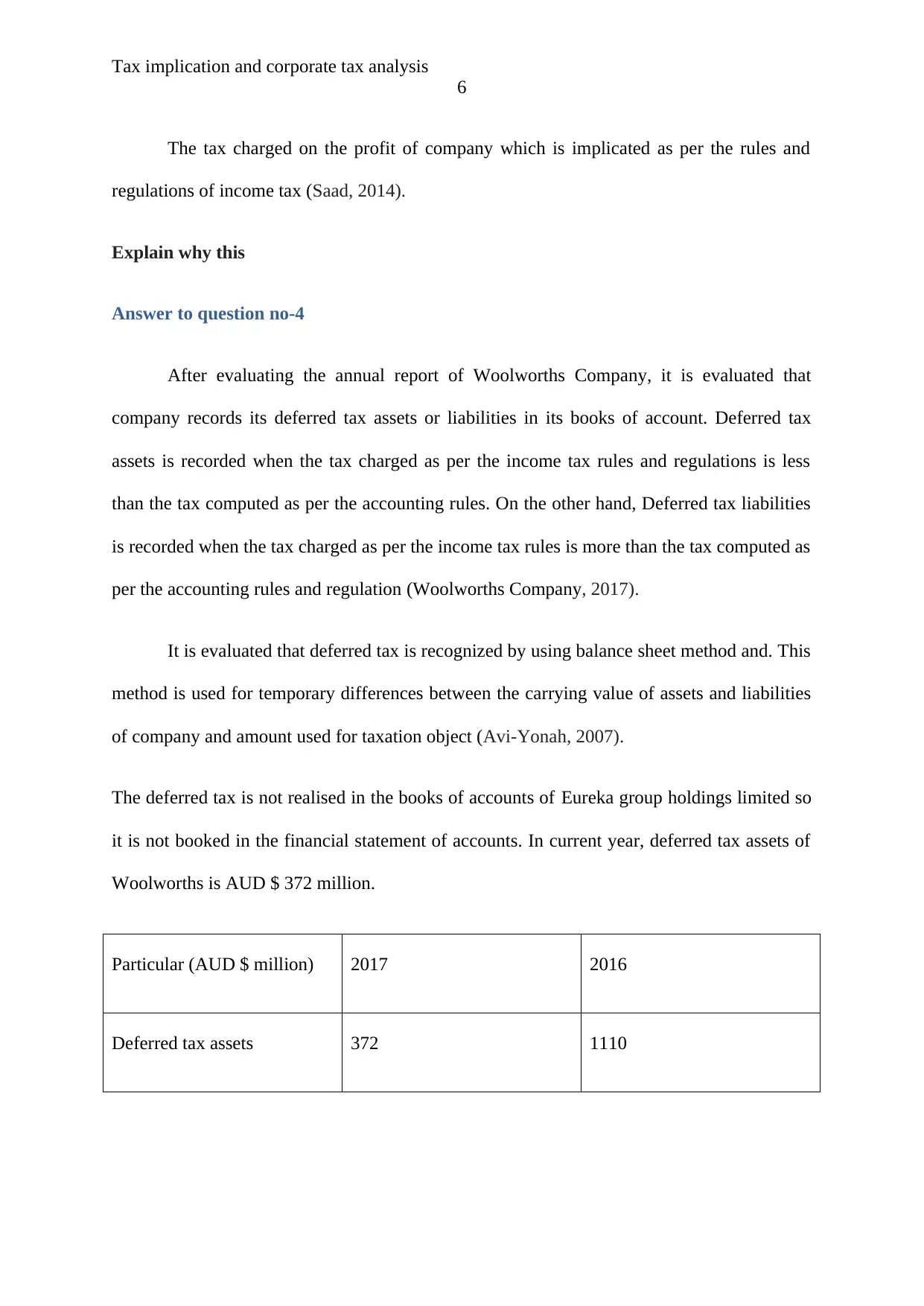
Tax implication and corporate tax analysis
6
The tax charged on the profit of company which is implicated as per the rules and
regulations of income tax (Saad, 2014).
Explain why this
Answer to question no-4
After evaluating the annual report of Woolworths Company, it is evaluated that
company records its deferred tax assets or liabilities in its books of account. Deferred tax
assets is recorded when the tax charged as per the income tax rules and regulations is less
than the tax computed as per the accounting rules. On the other hand, Deferred tax liabilities
is recorded when the tax charged as per the income tax rules is more than the tax computed as
per the accounting rules and regulation (Woolworths Company, 2017).
It is evaluated that deferred tax is recognized by using balance sheet method and. This
method is used for temporary differences between the carrying value of assets and liabilities
of company and amount used for taxation object (Avi-Yonah, 2007).
The deferred tax is not realised in the books of accounts of Eureka group holdings limited so
it is not booked in the financial statement of accounts. In current year, deferred tax assets of
Woolworths is AUD $ 372 million.
Particular (AUD $ million) 2017 2016
Deferred tax assets 372 1110
6
The tax charged on the profit of company which is implicated as per the rules and
regulations of income tax (Saad, 2014).
Explain why this
Answer to question no-4
After evaluating the annual report of Woolworths Company, it is evaluated that
company records its deferred tax assets or liabilities in its books of account. Deferred tax
assets is recorded when the tax charged as per the income tax rules and regulations is less
than the tax computed as per the accounting rules. On the other hand, Deferred tax liabilities
is recorded when the tax charged as per the income tax rules is more than the tax computed as
per the accounting rules and regulation (Woolworths Company, 2017).
It is evaluated that deferred tax is recognized by using balance sheet method and. This
method is used for temporary differences between the carrying value of assets and liabilities
of company and amount used for taxation object (Avi-Yonah, 2007).
The deferred tax is not realised in the books of accounts of Eureka group holdings limited so
it is not booked in the financial statement of accounts. In current year, deferred tax assets of
Woolworths is AUD $ 372 million.
Particular (AUD $ million) 2017 2016
Deferred tax assets 372 1110
⊘ This is a preview!⊘
Do you want full access?
Subscribe today to unlock all pages.

Trusted by 1+ million students worldwide
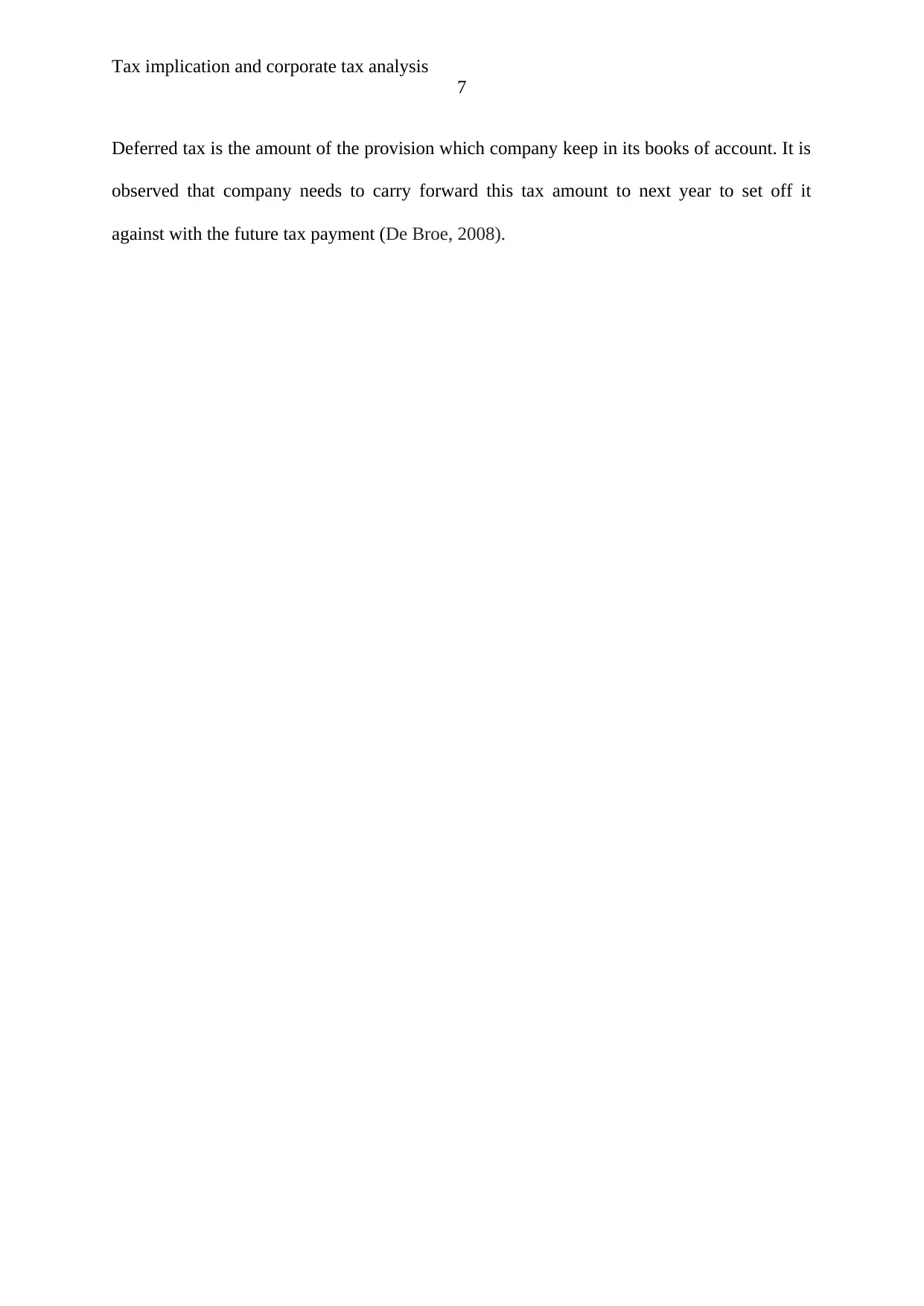
Tax implication and corporate tax analysis
7
Deferred tax is the amount of the provision which company keep in its books of account. It is
observed that company needs to carry forward this tax amount to next year to set off it
against with the future tax payment (De Broe, 2008).
7
Deferred tax is the amount of the provision which company keep in its books of account. It is
observed that company needs to carry forward this tax amount to next year to set off it
against with the future tax payment (De Broe, 2008).
Paraphrase This Document
Need a fresh take? Get an instant paraphrase of this document with our AI Paraphraser
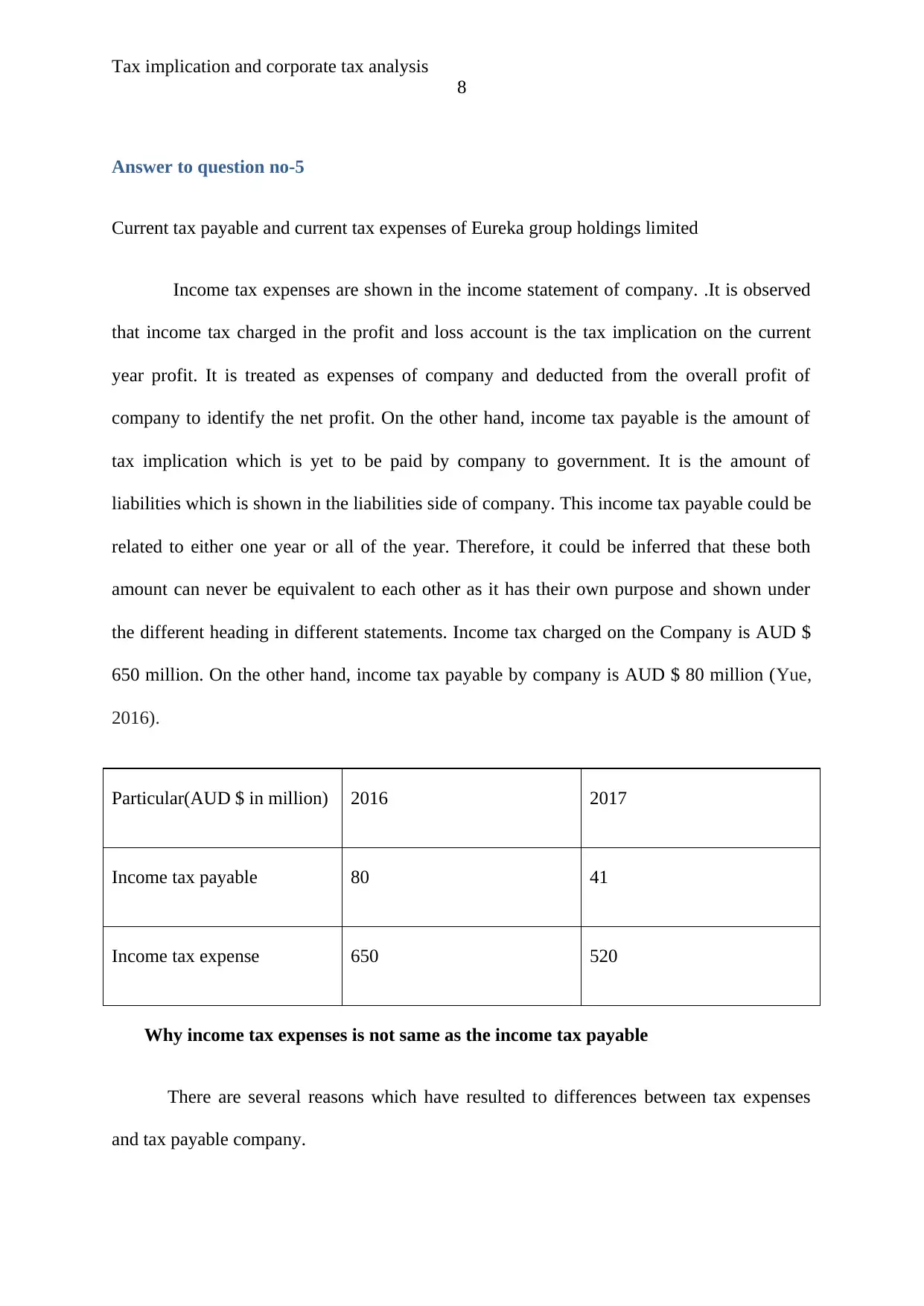
Tax implication and corporate tax analysis
8
Answer to question no-5
Current tax payable and current tax expenses of Eureka group holdings limited
Income tax expenses are shown in the income statement of company. .It is observed
that income tax charged in the profit and loss account is the tax implication on the current
year profit. It is treated as expenses of company and deducted from the overall profit of
company to identify the net profit. On the other hand, income tax payable is the amount of
tax implication which is yet to be paid by company to government. It is the amount of
liabilities which is shown in the liabilities side of company. This income tax payable could be
related to either one year or all of the year. Therefore, it could be inferred that these both
amount can never be equivalent to each other as it has their own purpose and shown under
the different heading in different statements. Income tax charged on the Company is AUD $
650 million. On the other hand, income tax payable by company is AUD $ 80 million (Yue,
2016).
Particular(AUD $ in million) 2016 2017
Income tax payable 80 41
Income tax expense 650 520
Why income tax expenses is not same as the income tax payable
There are several reasons which have resulted to differences between tax expenses
and tax payable company.
8
Answer to question no-5
Current tax payable and current tax expenses of Eureka group holdings limited
Income tax expenses are shown in the income statement of company. .It is observed
that income tax charged in the profit and loss account is the tax implication on the current
year profit. It is treated as expenses of company and deducted from the overall profit of
company to identify the net profit. On the other hand, income tax payable is the amount of
tax implication which is yet to be paid by company to government. It is the amount of
liabilities which is shown in the liabilities side of company. This income tax payable could be
related to either one year or all of the year. Therefore, it could be inferred that these both
amount can never be equivalent to each other as it has their own purpose and shown under
the different heading in different statements. Income tax charged on the Company is AUD $
650 million. On the other hand, income tax payable by company is AUD $ 80 million (Yue,
2016).
Particular(AUD $ in million) 2016 2017
Income tax payable 80 41
Income tax expense 650 520
Why income tax expenses is not same as the income tax payable
There are several reasons which have resulted to differences between tax expenses
and tax payable company.

Tax implication and corporate tax analysis
9
Income tax expenses are tax charged on the current year profit. Income tax
payable is amount of total tax payable liabilities which company needs to pay
to government.
Income tax recorded in the profit and loss account. On the other hand, income
tax payable is recorded in the balance sheet of company (De Broe, 2008).
Answer to question no-6
Is income tax expenses shown in the income statement is not equal to income tax paid in the
cash flow statement? If not
After analysing the annual report of company, it is observed that income tax expenses
shown in the income statement is not equal to income tax paid in the cash flow statement.
Why are the differences?
Cash flow statement is accompanied with the detail of cash inflow and outflow from
the business in current year irrespective of the fact whether it relates to present year of future
year. Cash flow statement is used by management of company to make effective management
of the cash related issues (Brigham and Ehrhardt, 2013). It is observed that income tax
expenses shown in the books of account of company are not equal to the income tax amount
shown in the profit and loss account of company. It is observed that income tax charged in
the profit and loss account is the tax implication on the current year profit. On the other hand,
income tax shown in the cash flow statement of company is the total amount paid by
company in the particular year irrespective of the fact whether it relates to present year of
future year. Cash flow statement reveals each and every single detail about the cash inflow
and outflow from the business. Profit and loss account is prepared with a view to identify the
true and fair view of income earned by company. Therefore, it could be concluded that both
9
Income tax expenses are tax charged on the current year profit. Income tax
payable is amount of total tax payable liabilities which company needs to pay
to government.
Income tax recorded in the profit and loss account. On the other hand, income
tax payable is recorded in the balance sheet of company (De Broe, 2008).
Answer to question no-6
Is income tax expenses shown in the income statement is not equal to income tax paid in the
cash flow statement? If not
After analysing the annual report of company, it is observed that income tax expenses
shown in the income statement is not equal to income tax paid in the cash flow statement.
Why are the differences?
Cash flow statement is accompanied with the detail of cash inflow and outflow from
the business in current year irrespective of the fact whether it relates to present year of future
year. Cash flow statement is used by management of company to make effective management
of the cash related issues (Brigham and Ehrhardt, 2013). It is observed that income tax
expenses shown in the books of account of company are not equal to the income tax amount
shown in the profit and loss account of company. It is observed that income tax charged in
the profit and loss account is the tax implication on the current year profit. On the other hand,
income tax shown in the cash flow statement of company is the total amount paid by
company in the particular year irrespective of the fact whether it relates to present year of
future year. Cash flow statement reveals each and every single detail about the cash inflow
and outflow from the business. Profit and loss account is prepared with a view to identify the
true and fair view of income earned by company. Therefore, it could be concluded that both
⊘ This is a preview!⊘
Do you want full access?
Subscribe today to unlock all pages.

Trusted by 1+ million students worldwide
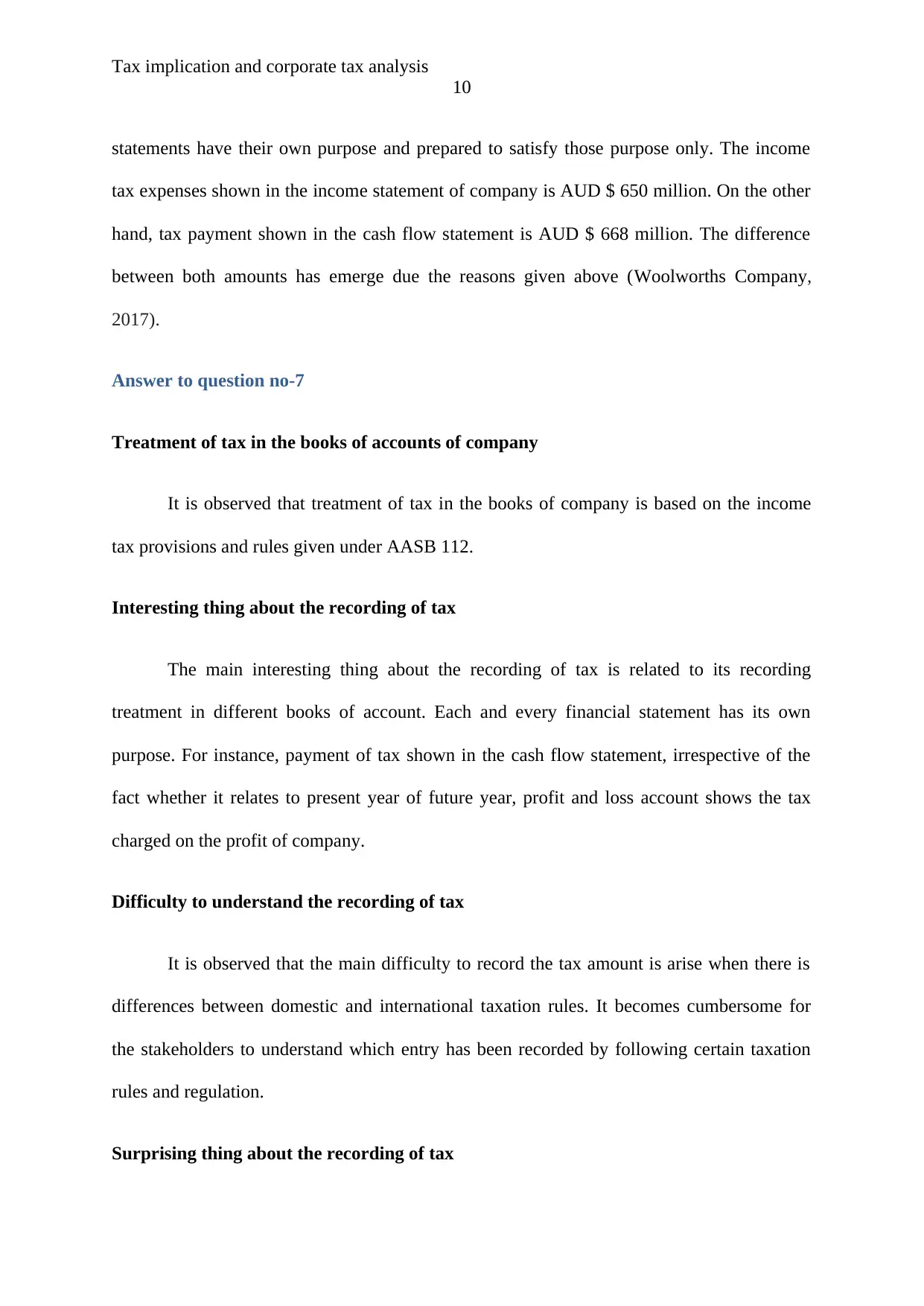
Tax implication and corporate tax analysis
10
statements have their own purpose and prepared to satisfy those purpose only. The income
tax expenses shown in the income statement of company is AUD $ 650 million. On the other
hand, tax payment shown in the cash flow statement is AUD $ 668 million. The difference
between both amounts has emerge due the reasons given above (Woolworths Company,
2017).
Answer to question no-7
Treatment of tax in the books of accounts of company
It is observed that treatment of tax in the books of company is based on the income
tax provisions and rules given under AASB 112.
Interesting thing about the recording of tax
The main interesting thing about the recording of tax is related to its recording
treatment in different books of account. Each and every financial statement has its own
purpose. For instance, payment of tax shown in the cash flow statement, irrespective of the
fact whether it relates to present year of future year, profit and loss account shows the tax
charged on the profit of company.
Difficulty to understand the recording of tax
It is observed that the main difficulty to record the tax amount is arise when there is
differences between domestic and international taxation rules. It becomes cumbersome for
the stakeholders to understand which entry has been recorded by following certain taxation
rules and regulation.
Surprising thing about the recording of tax
10
statements have their own purpose and prepared to satisfy those purpose only. The income
tax expenses shown in the income statement of company is AUD $ 650 million. On the other
hand, tax payment shown in the cash flow statement is AUD $ 668 million. The difference
between both amounts has emerge due the reasons given above (Woolworths Company,
2017).
Answer to question no-7
Treatment of tax in the books of accounts of company
It is observed that treatment of tax in the books of company is based on the income
tax provisions and rules given under AASB 112.
Interesting thing about the recording of tax
The main interesting thing about the recording of tax is related to its recording
treatment in different books of account. Each and every financial statement has its own
purpose. For instance, payment of tax shown in the cash flow statement, irrespective of the
fact whether it relates to present year of future year, profit and loss account shows the tax
charged on the profit of company.
Difficulty to understand the recording of tax
It is observed that the main difficulty to record the tax amount is arise when there is
differences between domestic and international taxation rules. It becomes cumbersome for
the stakeholders to understand which entry has been recorded by following certain taxation
rules and regulation.
Surprising thing about the recording of tax
Paraphrase This Document
Need a fresh take? Get an instant paraphrase of this document with our AI Paraphraser

Tax implication and corporate tax analysis
11
It is evaluated that company can shows its liabilities of its tax payment as deferred tax
assets or deferred tax liabilities. However, the main surprising thing to notice in this case is
related to recording of deferred tax liabilities or deferred tax assets in the books of account of
company. A company can never have deferred tax liabilities or deferred tax assets in the
books of account of company both at the same time (Feldstein, 2009).
New Insight about the recording of taxes
It is understood that in order to comply with the international taxation rules and
domestic taxation rules, company needs to establish harmonization in its recording of tax
amount in the books of account of company by following AASB 112 (Garrett, Hoitash and
Prawitt, 2014).
11
It is evaluated that company can shows its liabilities of its tax payment as deferred tax
assets or deferred tax liabilities. However, the main surprising thing to notice in this case is
related to recording of deferred tax liabilities or deferred tax assets in the books of account of
company. A company can never have deferred tax liabilities or deferred tax assets in the
books of account of company both at the same time (Feldstein, 2009).
New Insight about the recording of taxes
It is understood that in order to comply with the international taxation rules and
domestic taxation rules, company needs to establish harmonization in its recording of tax
amount in the books of account of company by following AASB 112 (Garrett, Hoitash and
Prawitt, 2014).
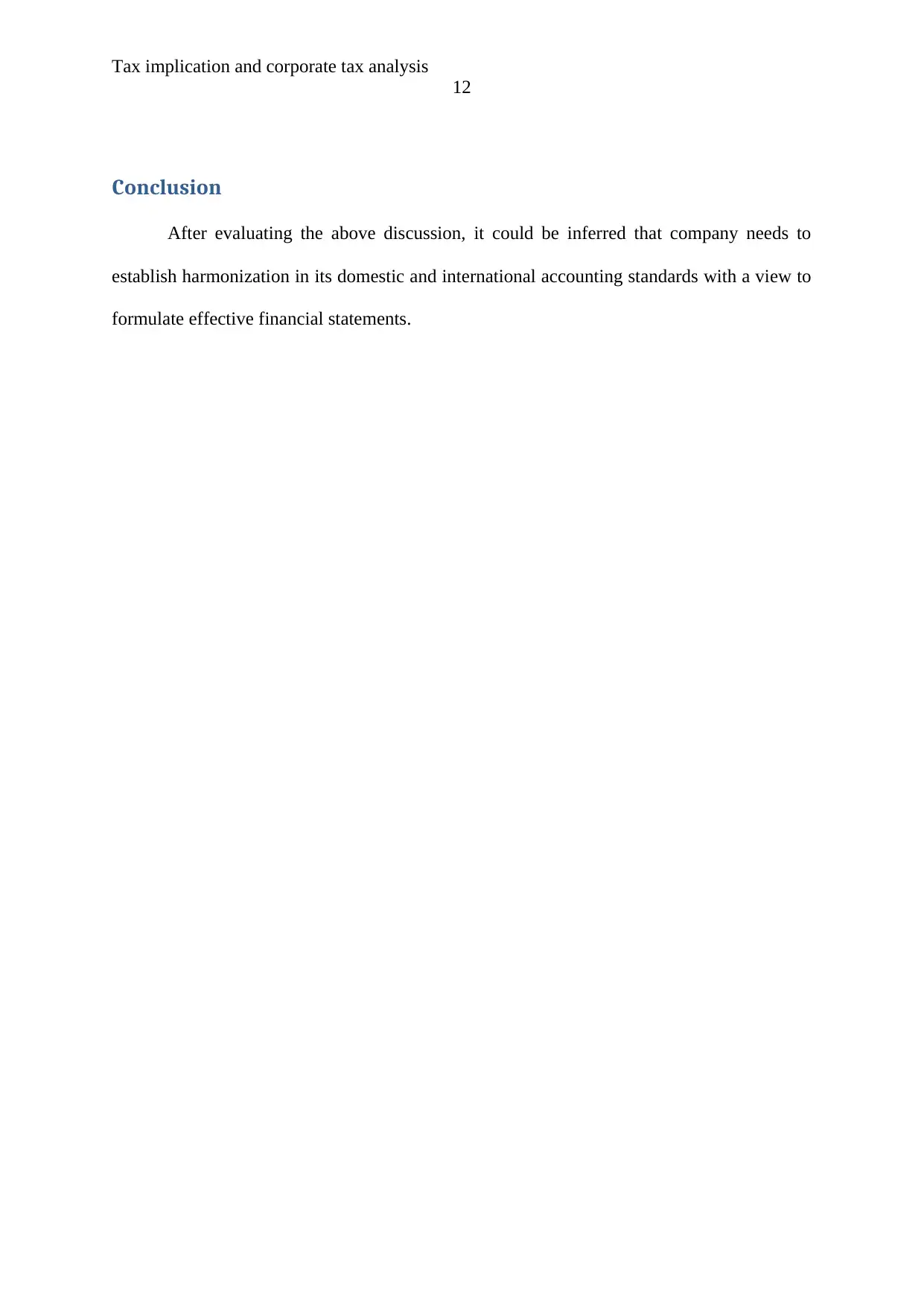
Tax implication and corporate tax analysis
12
Conclusion
After evaluating the above discussion, it could be inferred that company needs to
establish harmonization in its domestic and international accounting standards with a view to
formulate effective financial statements.
12
Conclusion
After evaluating the above discussion, it could be inferred that company needs to
establish harmonization in its domestic and international accounting standards with a view to
formulate effective financial statements.
⊘ This is a preview!⊘
Do you want full access?
Subscribe today to unlock all pages.

Trusted by 1+ million students worldwide
1 out of 12
Related Documents
Your All-in-One AI-Powered Toolkit for Academic Success.
+13062052269
info@desklib.com
Available 24*7 on WhatsApp / Email
![[object Object]](/_next/static/media/star-bottom.7253800d.svg)
Unlock your academic potential
Copyright © 2020–2025 A2Z Services. All Rights Reserved. Developed and managed by ZUCOL.





